
This page is part of © FOTW Flags Of The World website
Dictionary of Vexillology: T (Tribal Flag - Triskelion)
Last modified: 2015-05-26 by rob raeside
Keywords: vexillological terms |
Links: FOTW homepage |
search |
disclaimer and copyright |
write us |
mirrors
On this page:
TRIBAL FLAG
The sub-national flag of any group which shares an ethnic origin, but
which is not internationally recognized as independent but see national
flag 2) and political flag 1)
(also sub-national flag).
![[tribal flags illustration]](../images/v/vxt-d512.gif)
From left: Navaho Nation, US (fotw); Arapaho Nation, US
(fotw); Chickasaw Nation, US (fotw)
Please note that a tribal flag may also be a
political flag under certain circumstances, and that some tribal flags may be
considered as national flags dependent upon the legal status and/or ambitions
of the tribal group concerned.
![[tribal flags which serve as political or national flags]](../images/v/vxt-d512a.gif)
From left: The Kurds, Iraq (fotw); The Aboriginals, A
National Flag of Australia Under The Law (CS)
TRIBAND (or TRI-BAND)
1) A flag of three (usually) parallel stripes or bands but using only two colours.
These stripes may be disposed vertically, horizontally or diagonally, be of
equal or unequal width and be either defaced or plain a three-striped flag
or tiercι (see also bar, deface,
fess, pale,
plain 2), stripe,
striped, tiercι,
tricolour, unequal triband and width
2)).
2) An undefaced flag with three equal parallel stripes or bands using two
colours whether disposed vertically or horizontally a simple triband (see also undefaced).
3) Informally, any flag of three parallel stripes or bands in either two
colours or three. These stripes may be disposed vertically, horizontally or
diagonally, be of equal or unequal width and be either defaced or plain but
see notes below.
![[Triband example]](../images/v/vxt-d1750.gif)
![[Triband example]](../images/v/vxt-d1751.gif)
![[Triband example]](../images/v/vxt-d1753.gif)
![[Triband example]](../images/v/vxt-d1752.gif)
Civil Flag/Ensign of Guatemala (fotw); National Flag of Argentina (fotw); Flag of
Carpena, Brazil (fotw); Flag of
Cruzaltense, Brazil (fotw)
Notes:
a) With regard to 1) and 2), the
Editors have drawn a distinction between flags with three parallel stripes and
three colours and those having three parallel stripes and only two colours,
with the definitions for tricolour and triband having been carefully drawn up
using all available sources, however, please see further note below.
b) With regard to 3) it should be further noted
that this definition includes not only all flags detailed in 1) and 2) above,
but also those described under tricolour, and it is strongly suggested that
these entries be consulted before usage.
c) With regard to diagonal tribands, the orientation of its central stripe can be critical
to this definition if the charge in question runs directly into the corners then it can be
considered as a flag bearing a diagonal stripe (as per the example illustrated below), if
however, the central stripe has its entire width along either the top and bottom edges and/or
along the hoist and fly then the term diagonal triband may be used in description see
north-south diagonal 1) and its references.
![[diagonal stripe example]](../images/v/vxt-d1754.gif)
Flag of Araruna, Brazil (fotw)
TRIBAR (or TRI-BAR)
A term sometimes applied to a flag of three stripes in two colours
but see triband and the note below.
Please note however, before using this term it
is suggested that the entry on bar and/or a
suitable glossary or heraldic dictionary be consulted.
TRICOLORE, LA
The national flag, civil ensign and naval ensign of Italy
- see tricolour 1) and tricolour 2) (also ropework border).
![[La Tricolore]](../images/v/vxt-d959.gif)
![[La Tricolore]](../images/v/vxt-d959a.gif)
![[La Tricolore]](../images/v/vxt-d959b.gif)
National Flag, Civil Ensign and
Naval Ensign of Italy
(fotw)
TRICOLORE, LE
The national flag of France, see tricolour
1) and tricolour
2).
![[Tricolor example]](../images/v/vxt-d329.gif)
![[Tricolor example]](../images/v/vxt-d329e.gif)
National Flags of France for Use on Land and at Sea
TRICOLOUR (TRICOLOR, TRI-COLOUR or TRI-COLOR)
1) A flag of three (usually) parallel stripes or bands in three different colours. These
stripes may be disposed vertically, horizontally or diagonally, be of equal or unequal width and
be either defaced or plain a three-striped flag or tiercé (see also deface, plain
2), stripe, striped,
tiercι, triband,
unequal triband
and width 2)).
2) An undefaced flag with three equal parallel stripes or bands of
different colours whether disposed vertically or horizontally a simple tricolour for example: the national flag of
France - le tricolore, the national flag of Italy
- la tricolore or that of the Netherlands
- the driekleur - but see the second note below (also undefaced
and princeflag).
![[Tricolor example]](../images/v/vxt-d2365.gif)
![[Tricolor example]](../images/v/vxt-d2366.gif)
![[Tricolor example]](../images/v/vxt-d329d.gif)
![[Tricolor example]](../images/v/vxt-d2437.gif)
![[Tricolor example]](../images/v/vxt-d329c.gif)
National Flag of Mali (fotw);
National Flag of Bolivia (fotw);
National Flag of St Vincent (fotw);
Flag of Algar, Spain (Klaus-Michael Schneider);
National Flag of Ecuador
(fotw).
Notes:
a) The definition of tricolour (as
given herein) is restricted to flags of three colours disposed in three
parallel stripes, and that flags that do not fall into this category are
defined elsewhere. The Editors have also drawn a distinction between flags
with three parallel stripes and three colours, and those consisting of three
parallel stripes but only two colours, with the definitions for tricolour and
triband having been carefully drawn up using all available sources, however
this distinction is not always observed (see also triband
3)).
b) With regard to 2), many
national flags, in addition to the three examples given above, are referred to
as a tricolour in their respective languages, for example the five striped flag of Thailand the Trairanga. .
c) With regard to diagonal tricolours, the orientation of its central stripe can be critical to
this definition if the charge in question runs directly into the corners then it can be
considered a flag bearing a diagonal stripe (as per the example illustrated below), if however,
the central stripe has its entire width along either the top and bottom edges and/or along the
hoist and fly then the term "diagonal tricolour" may be used in description see
north-south diagonal 1) and its references.
![[diagonal stripe example]](../images/v/vxt-d1755.gif)
Flag of Roraima, Brazil (fotw)
TRICOLOUR PENDANT (or PENNANT)
See common pendant.

The Tricolour/Common Pendant, England then UK 1661 – c1850 (fotw)
TRIMMED
See garnished.
![[Kinrooi, Belgium]](../images/v/vxt-d1166.gif)
Flag of Kinrooi Belgium (fotw)
TRINACRIA
See triskelion.
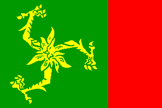
Flag of Eagum, Netherlands (fotw)
TRINITARIAN CROSS
A term that is used to describe the (layered) cross of the Catholic Order
of the Holy Trinity in which a blue horizontal arm is overlaid by a red
vertical. (see also 'layered cross'
and 'layered saltire').
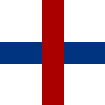
The Order of the Holy Trinity (Wiki)
TRINITY EYE
See Eye of God.
![[Radzymin, Poland]](../images/v/vxt-d1180.gif)
![[Radzymin, Poland]](../images/v/vxt-d1180a.gif)
Flag and Arms of Radzymin Poland (fotw)
TRIPARTITE (TRIPARTED or TRIPLE-PARTED)
The term for a charge, particularly (but not exclusively) a cross or
saltire, that is divided longitudinally into three parts in three different
colours, as in the flag of Dominica triparted or triple-parted (see also cross
3), layered cross and layered
saltire).
![[Dominica - Tripartite example]](../images/v/vxt-d331.gif)
![[Guatavita Colombia]](../images/v/vxt-d331a.gif)
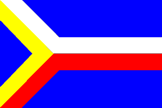
From left: National Flag of Dominica
(fotw); Flag of
Guatavita, Colombia (fotw); Flag of
Grathem, The Netherlands (fotw)
TRIPLE-ARMED (or TRIPLE) CROSS
1) See papal cross
2) See orthodox cross.
![[example]](../images/v/vxt-d1023b.gif)
![[example]](../images/v/vxt-d1023a.gif) S
S
TRIPLE-MOUNT (or TRIPLEMOUNTED)
See coupeau (also mount).
![[triple mount example]](../images/v/vxt-d1024.gif)
Flag of Savski Venac, Serbia (fotw)
TRIPLE-FIMBRIATED
See cotticed 1) and following note
(also fimbriated).
![[triple fimbriated example]](../images/v/vxt-d1413a.gif)
![[triple fimbriated example]](../images/v/vxt-d1413b.gif)
TRIPLE-PRINCE
The term for a 17th Century Dutch naval flag of usually (but not
invariably) nine even, horizontal stripes in the Dutch national colours
repeated but see double-prince
(also dreikleur and princeflag)
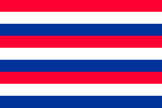
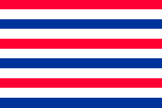
From left: Triple Prince c1660 (fotw); With
Eleven
Stripes c1660 (fotw)
Please note however, whilst all available
evidence suggests that red, white and blue were employed, orange instead of
red may have been used at an earlier stage.
TRIPLE-SWALLOW-TAIL(ED)
A term sometimes mistakenly used in place of swallowtail and tongue or
triple-tailed see swallow-tail
and tongue and triple-tailed 2).
TRIPLE-TAILED (or TRIPLE-TONGUED)
1) See swallow-tail and tongue.
2) A term that should be used when a flag has three tails or tongues whose
width and lengths are of equal size (see also length
2), tails, tongues, triangular-tongued
and width 2)).
![[Triple-tailed example]](../images/v/vxt-d576.gif)
![[Triple-tailed example]](../images/v/vxt-d2203.gif)
Naval Ensign of Estonia (fotw);
Flag of Bajerov, Slovakia (fotw)
TRIPLE-TAILED DESCATE
(adj) A term used to describe a fly that is cut into three tails with
rounded ends (see also double-tailed
descate, fly, gonfanon,
guidon 2), standard
4), swallowtail, swallowtail
and tongue, tongue(s) and tails).
![[Triple-tailed descate example]](../images/v/vxt-d333.gif)
TRIPPANT
See appendix V.
![[Lengnau]](../images/v/vxt-d1181.gif)
Flag of Lengnau, Switaerland (fotw)
TRISKELION (TRISKELE)
An originally mystical sign of ancient origin that consists of three
symbols emanating from a central point, and of which the three-legged symbols
on the flags of the Islands of Man and Sicily (for example) are almost
certainly an adaptation - a trinacria or triskele
![[Triskelion example]](../images/v/vxt-d335.gif)
![[Triskelion example]](../images/v/vxt-d335a.gif)
![[Triskelion example]](../images/v/vxt-d335b.gif)
![[Triskelion example]](../images/v/vxt-d1783.gif)
From left; Flag of the Isle of Man,
UK (fotw); Flag of Sicily (fotw); Symbol from Celtic
Art (Wikipedia); Flag of Ust-Ord Buratia, Russia (fotw)
Introduction | Table of Contents
| Index of Terms | Previous Page | Next Page
![[tribal flags illustration]](../images/v/vxt-d512.gif)
![[tribal flags which serve as political or national flags]](../images/v/vxt-d512a.gif)

![[Triband example]](../images/v/vxt-d1750.gif)
![[Triband example]](../images/v/vxt-d1751.gif)
![[Triband example]](../images/v/vxt-d1753.gif)
![[Triband example]](../images/v/vxt-d1752.gif)
![[diagonal stripe example]](../images/v/vxt-d1754.gif)
![[La Tricolore]](../images/v/vxt-d959.gif)
![[La Tricolore]](../images/v/vxt-d959a.gif)
![[La Tricolore]](../images/v/vxt-d959b.gif)
![[Tricolor example]](../images/v/vxt-d329.gif)
![[Tricolor example]](../images/v/vxt-d329e.gif)
![[Tricolor example]](../images/v/vxt-d2365.gif)
![[Tricolor example]](../images/v/vxt-d2366.gif)
![[Tricolor example]](../images/v/vxt-d329d.gif)
![[Tricolor example]](../images/v/vxt-d2437.gif)
![[Tricolor example]](../images/v/vxt-d329c.gif)
![[diagonal stripe example]](../images/v/vxt-d1755.gif)

![[Kinrooi, Belgium]](../images/v/vxt-d1166.gif)


![[Radzymin, Poland]](../images/v/vxt-d1180.gif)
![[Radzymin, Poland]](../images/v/vxt-d1180a.gif)
![[Dominica - Tripartite example]](../images/v/vxt-d331.gif)
![[Guatavita Colombia]](../images/v/vxt-d331a.gif)

![[example]](../images/v/vxt-d1023b.gif)
![[example]](../images/v/vxt-d1023a.gif)
![[triple mount example]](../images/v/vxt-d1024.gif)
![[triple fimbriated example]](../images/v/vxt-d1413a.gif)
![[triple fimbriated example]](../images/v/vxt-d1413b.gif)


![[Triple-tailed example]](../images/v/vxt-d576.gif)
![[Triple-tailed example]](../images/v/vxt-d2203.gif)
![[Triple-tailed descate example]](../images/v/vxt-d333.gif)
![[Lengnau]](../images/v/vxt-d1181.gif)
![[Triskelion example]](../images/v/vxt-d335.gif)
![[Triskelion example]](../images/v/vxt-d335a.gif)
![[Triskelion example]](../images/v/vxt-d335b.gif)
![[Triskelion example]](../images/v/vxt-d1783.gif)